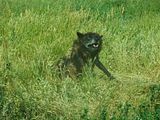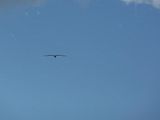In the news,
"Just as some flowers use bright colors to attract insect pollinators, other plants may use sound to lure in nectar-eating bats.
One rain forest vine has a dish-shaped leaf located above a cluster of flowers that appears to help bats find them (and the plant's tasty nectar) by reflecting back the calls the flying mammals send out, new research indicates.
While there is other evidence that plants use bats' sonar systems to attract them, this is the first time scientists have shown that a plant can produce an "echo beacon" that cuts through sonic clutter of reflected echoes, and that this signal can cut a bat's search time for food in half, according to the researchers, led by Ralph Simon, a research fellow at the University of Ulm in Germany.
The vine, Marcgravia evenia, climbs trees in the rain forests of southeastern Cuba. Its flowers are suspended in a ring, above cuplike structures that hold sugary nectar intended to lure batty pollinators, whose necks and shoulders are powdered with pollen as they drink the nectar. The bats then carry the pollen between vines, fertilizing other flowers with it and helping the vine reproduce.
Like a satellite dish, the reflector leaf is concave, and stands in an upright position above the ring of flowers.
Bats navigate and search for food by sending out high-frequency calls, and then listening to the echoes that bounce back.
And like bats would, the researchers bounced sound off the dish-shaped leaves as well as off regular foliage leaves and then analyzed the echoes that came back. They found that a strong, constant echo could be detected within a roughly 100-degree range around the front of the dish-shaped leaves. Meanwhile, the echo from the foliage leaves was not constant, but varied drastically within 5-degree increments, making it less detectable. What's more, the dish-shaped leaves produced an echo with a distinctive, two-peak signal.
In another experiment, the researchers trained nectar-feeding bats to find a small, single feeder (a stand-in for a nectar-filled flower bloom) hidden within fake foliage in the rain forest. The bats then searched for the feeder, which was associated with a replica of a dish-shaped leaf, a foliage leaf or no leaf, as they were timed.
The bats took the longest to find the feeder when it had no leaf, though the foliage leaf did not significantly reduce the search time. However, the dish-shaped leaf cut down the bats' search time by roughly 50 percent relative to the feeder by itself.
The vine has a great deal to gain by attracting bats, according to Simon.
"Bats are very efficient pollinators, and they have large home ranges," Simon said. "(The vine) is a rare species with a patchy distribution pattern. These bats are extremely helpful, because they can exchange pollen between plants that grow far apart."
The research team included Marc Hodleried of the University of Bristol in the United Kingdom and Corinna Koch and Otto von Helversen of the University of Erlangen-Nuremburg in Germany. "
A Talking Plant calls out to Bats
Moderators: Kenya, webearthonline
- webearthonline
- Global Moderator
- Posts: 1826
- Joined: Sat Feb 03, 2007 9:18 am
- Contact:
-
Alpha Ridley
- Adult Mouse
- Posts: 744
- Joined: Sun Apr 17, 2011 1:06 pm
Re: A Talking Plant calls out to Bats
Wow... I never thought some bats eat nectar... O.o
Please join my Okavango Delta RP!
-
animalguy888
- Adult Gecko
- Posts: 1546
- Joined: Thu Apr 07, 2011 10:42 am
- Location: In the sky hunting for a hybrid between superman and bigfoot in an alternate universe
- Contact:
Re: A Talking Plant calls out to Bats
they do and so do some flys. I have heard of them.I also have heard of this stuff before its very interesting. Theres another cool plant that uses nector to attract animals. But this necter producing plant is not using them to pollinate but instead lead them to their doom. The Venus Fly Traps are plants that actually eat flys. (eat as in kill and consumes) The fly is attracted to the necter on the plants leaf. The plant also has 6 tiny hairs on the leaf. (Yes the venus fly trap basicly has sensory hairs.) when a fly feeding on nector accedently touches one of these hairs it will be timed. Another strike to a hair withen 20 seconds and in just a split secend the plants jaw like leaves will clamp shut like prison bars for the fly to be consumed. After 10 days of feeding on that one meal it opens its leaves ready to catch another fly leaving behind nothing but a husk. In some parts of the USA they sell venus fly traps as pets. Its even posible to feed them meat by placing a small peice on the leaves and then flicking the hairs a couple times.Alpha Ridley wrote:Wow... I never thought some bats eat nectar... O.o



"There is beauty in every Creature, Stone, and Plant. To find it you Just have to look for It."
Click here if you dare!...

-
SouthernStar
- Adult Rabbit
- Posts: 3900
- Joined: Tue Oct 13, 2009 8:01 am
Re: A Talking Plant calls out to Bats
You can feed them chicken burgers, but it is not advised. I feed my venus fly trap with flies who get trapped and tortured in the conservatory.
And you should never feed a venus flytrap with water that has chlorine. (Spell fail.)
And you should never feed a venus flytrap with water that has chlorine. (Spell fail.)
For science!